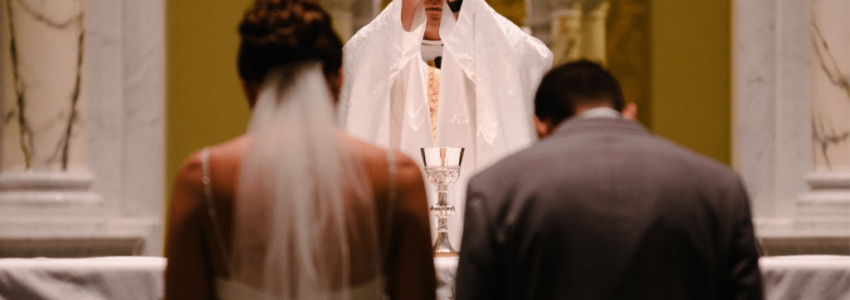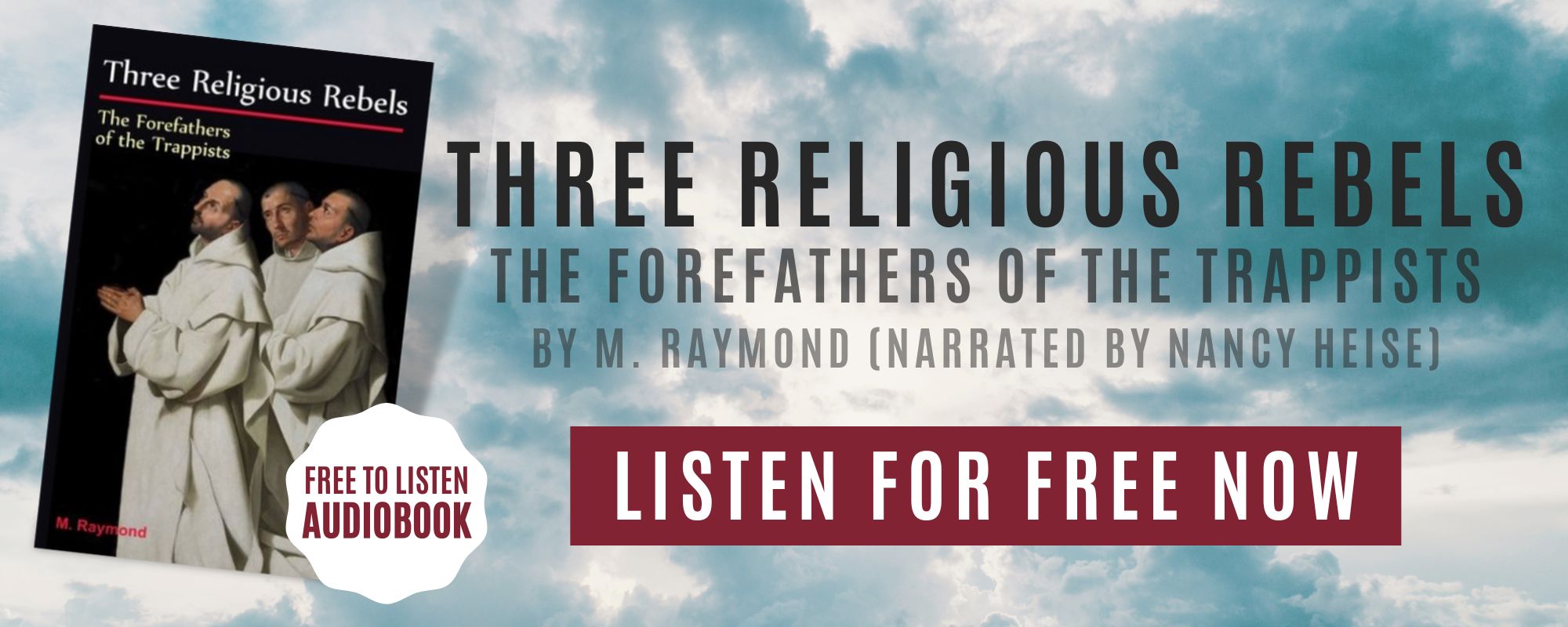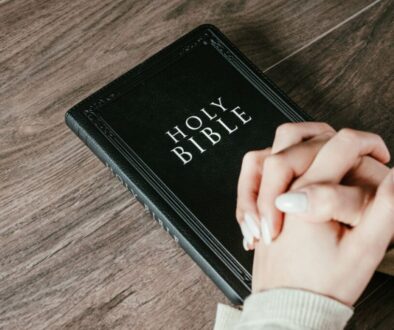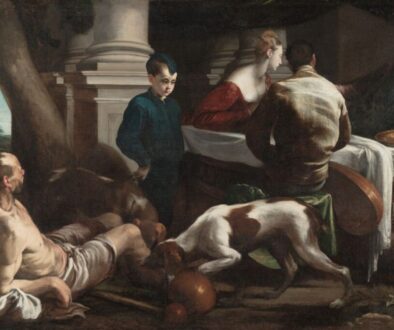The Catholic Wedding Ceremony: Then and Now

Published July 25, 2021
For Catholics, weddings are sacred affairs. It’s more than just a promise to stay with one person till death do you part. It’s about asking God to bless the union of two souls as they begin to share a life together in marriage.
Somehow, we’ve always imagined weddings to be grand celebrations. Brides are stressing about what to wear on the wedding day. Then comes the wedding planning itself which is basically just a never-ending checklist of to-do’s: the cakes, the flowers, the venue, the wedding invitations and even to the smallest details like a social media hashtag. Indeed, planning a wedding can be as full of trials as the actual marriage itself.
But did you know it wasn’t always that way? A traditional Catholic marriage ceremony from hundreds of years ago is significantly different from the ones we have today. Read on to find out what changed over the years.
Wedding Rites
Then
Catholic marriage ceremonies from hundreds of years ago were much shorter than today. Some parts of the ceremony were done in Latin, the language of the church. Mass and wedding ceremonies are two different celebrations. Couples can choose to have a mass or not after their wedding ceremony.
The parish priest (who usually officiates weddings until today) also don’t ask the crowd for any objections to the union. So people back then just simply have to forever hold their peace.
In medieval Scotland, a wedding tradition known as “handfasting” was popular among highlanders. Due to geographical restrictions, it takes a long time for a priest to reach a village. So when a couple wants to get married and can’t wait for a priest, they just bind their hands and say their vows. The ceremony is valid and the community recognizes them as a married couple. When a priest finally arrives (after about a year or two), he blesses the union.
Personal vows were also not common back then. The church was pretty adamant about keeping to the scriptures to preserve the sanctity of the ceremony. The kissing-the-bride part was done a little differently too. In the medieval times, the priest would give the groom a kiss of peace which the groom then passes to his wife.
Now
Today, Catholic wedding ceremonies are done within a mass. It’s still celebrated by a priest or a bishop but it has become more structured. The ceremony starts with a processional headed by the priest and servers then followed by the wedding entourage and lastly, the bride with her father.
When everyone is settled, the entrance rite will then start followed by the liturgy of the word. It’s only after this that the marriage rite will start. This is then followed by the Liturgy of the Eucharist and the Concluding Rite. That’s why a modern wedding ceremony usually takes more than an hour.
Just like in a regular mass, a wedding liturgy consist of readings from the Old and New Testament, a Gospel, and a Responsorial Psalm. At least one of these wedding readings will be explicitly about marriage. The marriage rite is also where we see the exchanging of vows and rings. While the concluding rite will include the Lords prayer, the sign of peace, holy communion, and the iconic tradition of kissing the bride followed by the nuptial blessings, and recessional.
The church has allowed couples to personalize their Prayer of the Faithful (general intercessions) too. Confession is now required for both the bride and the groom which is usually done before the actual wedding. They also have to take communion which can be before or during the wedding ceremony itself.
As to wedding vows, the couple can make their own or follow the traditional one. It’s usually preceded by questions from the priest about their certainty to enter into marriage. A traditional Catholic wedding vow goes like this:
“I, (your name), take you, (your husband/wife’s name), to be my wife/husband. I promise to be true to you in good times and in bad, in sickness and in health. I will love you and honor you all the days of my life.”
Family members and friends of the couple now also play a more active role in wedding ceremonies. Aside from being a bridesmaid or a groomsman, some couple would assign an altar server or lector from among their acquaintances. In certain instances, the priest would also allow a friend or family member of the couple to serve as extraordinary minister of holy communion.

Customs
Then
In medieval times, the best man serves a totally different purpose. He is there to prevent the wedding from being “interrupted”. He can be a relative or a friend but more often than not, he is not related to any of the wedding parties. He’s just the best swordsman the groom can afford.
Live rabbits instead of doves were also released as a symbol of fertility to the couple. The bride was presented with an infant which was meant to bring about a fruitful marriage. Brides also threw a shoe or bouquet to the bridesmaids to determine who will marry next.
Wedding cakes in medieval weddings also didn’t mean the kind of wedding cake we’re all familiar with today. Instead of multiple tiers of frosted spongy pastry, the couple would serve cookies, spice buns, and scones.
Now
In today’s wedding ceremonies, the infant becomes the flower girl or the ring bearer. Flower girls can be as many as the couples want. In many Hispanic weddings, couples would also exchange coins known as “arras”. This is in lieu of the dowry tradition which was a part of weddings many years back.
Considering that most brides of today wear stilettos to their weddings, it would be dangerous to throw a shoe at the bridesmaids. The throwing of bouquets is still being practiced but couples are getting more creative with that part of the ceremony. Most of the time, it’s done during reception rather than on the wedding ceremony itself.
A wedding cake has also become de rigueur for weddings today. It has become one of the highlights of the ceremony with couples willing to spend good money just to get the wedding cake of their dreams.
Venue
Then
Catholic weddings didn’t always happen inside the church. Hundreds of years ago, people would say their vows on the church’s front steps. That’s why Catholic churches back then typically has a “narthex” or porch leading up to the church’s door. The church doors would be closed to prevent anyone from getting in before the couple has exchanged vows. After this, a nuptial mass will be celebrated inside the church.
People can get married in their local parish church or a cathedral but monasteries and nunneries are a no-no.
Now
Today, it would be unthinkable to see a couple exchanging their vows on the church’s front steps. The whole ceremony had to be done inside. Besides, you don’t want the wedding guests to be soaking wet when it rains all of a sudden.
Couples who want to have their wedding other than in a church will have to secure permission from the bishop. Though in 2018, the Archdiocese of Baltimore launched a 12-month trial period where couples can pick their wedding venue. Certain places like nightclubs and bars are, of course, strictly prohibited.
Attire
Then
Traditional Catholic brides didn’t wear white. In fact, the color has been associated with mourning. Instead, brides would wear lively colors as a symbol of happiness and celebration. The term “something blue” also gives a clue as to the traditional wedding attire.
The wedding party’s attire also varies per culture. But the bride would wear their best dress. Bridesmaids usually dress like that of the bride. People believed that this will help confuse the evil spirits planning to harm the bride.
Veils in the medieval times were also worn as a part of the overall ensemble rather than just for the wedding itself. But by the Victorian era, long veils and trains became a must for most brides.
Now
Themed weddings are becoming increasingly popular nowadays. Though most brides still wear white, an increasing number also dresses according to the wedding’s theme.
Bridesmaids still wear uniform outfits but they are different from that of the bride’s. Bridal dresses also reflect the fashion of the times but must still follow the church’s regulations. As for the guests, they customarily wear white too. But in some themed weddings, the couple would ask the guests to throw on an attire that will fit with their theme.
Music
Then
Obviously, couples back in the day didn’t choose their wedding music by asking Google or hanging out in music streaming sites. The music for weddings back then and even up until the early 20th century were all provided by a band or an orchestra of some sort. Traditional musical instruments are typically used and the songs are either from the Psalms or folk music.
Now
With thousands of songs to chose from, wedding music nowadays usually reflect the taste and personality of the couple. Some would even compose their own songs to fully express how they feel. You can also hire songwriters to create a song especially for your wedding.
At the end of the day, weddings are just one-day events. Marriage, on the other hand, lasts a lifetime. So we should be more focused on preparing for the latter rather than the former.
[Related: How to Write a Catholic Wedding Program (With Template)]
Seek a Deeper Connection with God and Join Lay Cistercians of South Florida
Lay Cistercians of South Florida, is a community of lay people who seeks to have a deeper connection with God by living a life inspired by the monks and nuns through Lay Monasticism. Learn more about what is a Lay Cistercian on our website. Anyone who aspires to do the same as us, and is a confirmed Catholic is welcome to join us! We meet every second Saturday of the month at Emmanuel Catholic Church in Delray Beach, Florida.

This Content Has Been Reviewed For Accuracy
This content has undergone comprehensive fact-checking by our dedicated team of experts. Discover additional information about the rigorous editorial standards we adhere to on our website.

About The Author
Judy Ponio is a professional writer for the Lay Cistercians blog and a devoted Catholic. She works hard to ensure her work uses accurate facts by cross checking reputable sources.




